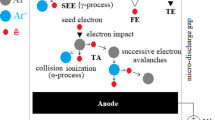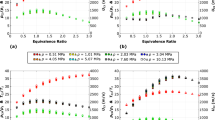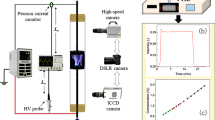Abstract
Reliable high-altitude relight is a key combustor requirement for the aero-engine. In general, low pressure and low temperature at high altitude will result in difficult ignition after extinction. In the present work, a simulated high-altitude test facility was designed to establish the capability of high-altitude relight testing. A multi-channel plasma igniter (MCPI) was proposed and designed to obtain reliable altitude ignition. Furthermore, the ignition performance of the MCPI and the traditional spark igniter was compared under varying high-altitude conditions. The separation of the breakdown stage from the discharge was confirmed by observing a time-phased breakdown process between multi-couple electrodes during MCPI discharge. Moreover, the discharge efficiency of the power source is increased from 17 to 36% by MCPI. A plasma kernel with high energy and strong penetration was generated within microsecond scale, while a flame kernel with high energy and large initial volume was formed on millisecond scale. In addition, the stable flame was obtained rapidly owing to the preheating evaporation area expansion, the improving mixture and the increasing heat release. MCPI extends the ignition limit FAR by 39%, 30% and 10% at ground level, 4 km and 8 km, respectively. The advantage of initial flame kernel from MCPI is that it resists heat loss at low temperature, while it does not perform well at extremely low pressure due to the spark-to-glow transition.

















Similar content being viewed by others
References
Serbin SI, Matveev IB, Mostipanenko GB (2011) Investigations of the working process in a “Lean-Burn” gas turbine combustor with plasma assistance. IEEE Trans Plasma Sci 39(12):3331–3335. https://doi.org/10.1109/TPS.2011.2166811
Mosbach T, Sadanandan R, Meier W et al (2010) Experimental analysis of altitude relight under realistic conditions using laser and high-speed video techniques//ASME Turbo Expo 2010: Power for Land, Sea, and Air. Am Soc Mech Eng 2010:523–532. https://doi.org/10.1115/GT2010-22625
Read R W (2008) Experimental investigations into high-altitude relight of a gas turbine. Ph.D. thesis, University of Cambridge. https://doi.org/10.17863/CAM.13977
Caines B, Hicks R, Wilson C (2001) Influence of sub-atmospheric conditions on the performance of an airblast atomiser//37th Joint Propulsion Conference and Exhibit 2001: 3573. https://doi.org/10.2514/6.2001-3573
Mastorakos E (2017) Forced ignition of turbulent spray flames. Proc Combust Inst 36(2):2367–2383. https://doi.org/10.1016/j.proci.2016.08.044
Ballal DR, Lefebvre AH (1981) A general model of spark ignition for gaseous and liquid fuel-air mixtures//Symposium (international) on combustion. Elsevier 18(1):1737–1746. https://doi.org/10.1016/S0082-0784(81)80178-6
Naegeli DW, Dodge LG (1991) Ignition study in a gas turbine combustor. Combust Sci Technol 80(4–6):165–184. https://doi.org/10.1080/00102209108951784
Lewis B, Von Elbe G (2012) Combustion, flames and explosions of gases. Elsevier
Chen Z, Ju Y (2007) Theoretical analysis of the evolution from ignition kernel to flame ball and planar flame. Combust Theor Model 11(3):427–453. https://doi.org/10.1080/13647830600999850
Brown MJ, McLean IC, Smith DB et al (1996) Markstein lengths of CO/H2/air flames, using expanding spherical flames//symposium (International) on combustion. Elsevier 26(1):875–881. https://doi.org/10.1016/S0082-0784(96)80297-9
Marchione T, Ahmed SF, Mastorakos E (2008) Ignition of turbulent swirling n-heptane spray flames using single and multiple sparks. Combust Flame 156(1):166–180. https://doi.org/10.1016/j.combustflame.2008.10.003
Yamada T, Matsubara Y, Kondo N (1999) Characteristics of multi spark ignition system. SAE Tech Paper 16:441–460. https://doi.org/10.4271/1999-01-0205
Hnatiuc B, Hnatiuc E, Pellerin S, Chapelle J (2006) Experimental analysis of a double-spark ignition system. Czech J Phys 56:851–867. https://doi.org/10.1007/s10582-006-0135-1
Ju Y, Sun W (2015) Plasma assisted combustion: Dynamics and chemistry. Prog Energy Combust Sci 48:21–83. https://doi.org/10.1016/j.pecs.2014.12.002
Starikovskaia SM (2006) Plasma assisted ignition and combustion. J Phys D Appl Phys 39(16):R265
Williams S, Popovic S, Vuskovic L, et al (2004) Model and igniter development for plasma assisted combustion//42nd AIAA Aerospace Sciences Meeting and Exhibit. https://doi.org/10.2514/6.2004-1012
Klimov A, Bityurin V, Kuznetsov A, et al (2004) External and internal plasma-assisted combustion//42nd AIAA Aerospace Sciences Meeting and Exhibit. https://doi.org/10.2514/6.2004-1014
Starikovskiy A, Aleksandrov N (2013) Plasma-assisted ignition and combustion. Prog Energy Combust Sci 39(1):61–110. https://doi.org/10.1016/j.pecs.2012.05.003
Cui W, Ren Y, Li S (2018) Stabilization of premixed swirl flames under flow pulsations using microsecond pulsed plasmas. J Propul Power 35(1):190–200. https://doi.org/10.2514/1.B37219
Mao X, Chen Q (2018) Effects of vibrational excitation on nanosecond discharge enhanced methane–air ignition. AIAA J 56(11):4312–4320. https://doi.org/10.2514/1.J057304
Yu S, Xie K, Tan Q et al (2015) Ignition improvement of premixed methane-air mixtures by distributed spark discharge. SAE Tech Paper. https://doi.org/10.4271/2015-01-1889
Schenk A, Rixecker G, Bohne S, et al (2014) The corona ignition system ecoflash®: New results with CNG engines and effects of engine-specific boundary conditions//2nd Int Conf Ignition Systems for Gasoline Engines. 2014: 24–25.
Briggs T, Alger T, Mangold B (2014) Advanced ignition systems evaluations for high-dilution SI engines. SAE Int J Engines 7(4):1802–1807. https://doi.org/10.4271/2014-01-2625
Anokhin EM, Kuzmenko DN, Kindysheva SV et al (2015) Ignition of hydrocarbon: air mixtures by a nanosecond surface dielectric barrier discharge. Plasma Sources Sci Technol 24(4):045014. https://doi.org/10.1088/0963-0252/24/4/045014
Boumehdi MA, Stepanyan SA, Desgroux P et al (2015) Ignition of methane-and n-butane-containing mixtures at high pressures by pulsed nanosecond discharge. Combust Flame 162(4):1336–1349. https://doi.org/10.1016/j.combustflame.2014.11.006
Shcherbanev S, Popov N, Starikovskaia S (2016) Multi-point ignition of hydrogen/air mixtures with single pulsed nanosecond surface dielectric barrier discharge. Morphology of the discharge in different gases at elevated pressures//54th AIAA Aerospace Sciences Meeting. https://doi.org/10.2514/6.2016-1692
Lin B, Wu Y, Zhang Z et al (2017) Multi-channel nanosecond discharge plasma ignition of premixed propane/air under normal and sub-atmospheric pressures. Combust Flame 182:102–113. https://doi.org/10.1016/j.combustflame.2017.04.022
Lin B, Wu Y, Zhang Z et al (2019) Ignition enhancement of lean propane/air mixture by multi-channel discharge plasma under low pressure. Appl Therm Eng 148:1171–1182. https://doi.org/10.1016/j.applthermaleng.2018.12.011
Zhang Z, Wu Y, Sun Z et al (2017) Experimental research on multichannel discharge circuit and multi-electrode plasma synthetic jet actuator. J Phys D Appl Phys 50(16):165205. https://doi.org/10.1088/1361-6463/aa6372
Jordan T, Bailey R (2008) NASA langley's AirSTAR testbed: a subscale flight test capability for flight dynamics and control system experiments//AIAA guidance, navigation and control conference and exhibit, 2008: 6660. https://doi.org/10.2514/6.2008-6660
Paxton B, Tambe SB, Jeng SM (2016) Systems design and experimental evaluation of a high-altitude relight test facility//ASME Turbo Expo 2016: turbomachinery technical conference and exposition. Am Soc Mech Eng Digital Collect. https://doi.org/10.1115/GT2016-57089
Pucher G, Allan WD (2004) Turbine fuel ignition and combustion facility for extremely low temperature conditions//ASME Turbo Expo 2004: power for land, sea, and air. Am Soc Mech Eng Digital Collect 2004:385–392. https://doi.org/10.1115/GT2004-53620
Atmosphere U (1976) United states committee on extension to the standard atmosphere. National Oceanic and Atmospheric Administration, Washington, DC (NOAA-S/T 76–15672): Supt. of Docs., US Gov Print Office (Stock No. 003–017–00323–0).
Karnani S, Dunn-Rankin D (2013) Visualizing CH* chemiluminescence in sooting flames. Combust Flame 160(10):2275–2278. https://doi.org/10.1016/j.combustflame.2013.05.002
Tamura M, Berg PA, Harrington JE et al (1998) Collisional quenching of CH (A), OH (A), and NO (A) in low pressure hydrocarbon flames. Combust Flame 114(3–4):502–514. https://doi.org/10.1016/S0010-2180(97)00324-6
Gaydon AG, Wolfhard HG (1979) Flames, their structure, radiation, and temperature. Chapman & Hall
Hall J, De Vries J, Amadio A, et al (2005) Towards a kinetics model of CH AIAA Aerospace Sciences Meeting and Exhibit. 2005: 1318. https://doi.org/10.2514/6.2005-1318
Renlund AM, Shokoohi F, Reisler H et al (1982) Reaction of ethynyl radical with oxygen Chemiluminescent products. J Phys Chem 86(21):4165–4170. https://doi.org/10.1021/j100218a015
Lefebvre AH (1998) Gas turbine combustion. CRC Press, Boca Raton
Kamenskihs V, Ng HD, Lee JH (2010) Measurement of critical energy for direct initiation of spherical detonations in stoichiometric high-pressure H2–O2 mixtures. Combust Flame 157(9):1795–1799. https://doi.org/10.1016/j.combustflame.2010.02.014
Xu D (2013) Thermal and hydrodynamic effects of nanosecond discharges in air and application to plasma-assisted combustion. Ph.D. thesis, Ecole Centrale Paris.
Watson EA (1956) Ignition research work carried out by the lucas organization with special reference to high altitude problems. Lucas Report No. L5988; also, Chart. Mech. Eng. 3: 91.
Maly R, Vogel M (1979) Initiation and propagation of flame fronts in lean CH4-air mixtures by the three modes of the ignition spark//Symposium (International) on Combustion. Elsevier 17(1):821–831. https://doi.org/10.1016/S0082-0784(79)80079-X
Chen Z, Burke MP, Ju Y (2011) On the critical flame radius and minimum ignition energy for spherical flame initiation. Proc Combust Inst 33(1):1219–1226. https://doi.org/10.1016/j.proci.2010.05.005
Padala S, Nishiyama A, Ikeda Y (2017) Flame size measurements of premixed propane-air mixtures ignited by microwave-enhanced plasma. Proc Combust Inst 36(3):4113–4119. https://doi.org/10.1016/j.proci.2016.06.168
Mikhailov VV, Lebedev VV, Mukhin AN (2010) Experimental development of a plasma spark plug for GTE altitude start. Rus Aeronaut (Iz VUZ) 53(2):235–241
Acknowledgements
This work is supported by the National Natural Science Foundation of China (NSFC) (Nos. 52007187, 91941301, 91941105).
Author information
Authors and Affiliations
Corresponding author
Additional information
Publisher's Note
Springer Nature remains neutral with regard to jurisdictional claims in published maps and institutional affiliations.
Rights and permissions
About this article
Cite this article
Lin, Bx., Wu, Y., Xu, Mx. et al. Experimental Investigation on High-Altitude Ignition and Ignition Enhancement by Multi-Channel Plasma Igniter. Plasma Chem Plasma Process 41, 1435–1454 (2021). https://doi.org/10.1007/s11090-021-10189-0
Received:
Accepted:
Published:
Issue Date:
DOI: https://doi.org/10.1007/s11090-021-10189-0




